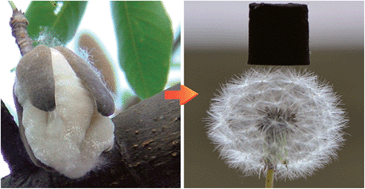Ultralight, compressible and multifunctional carbon aerogels based on natural tubular cellulose†
Abstract
Ultralight, compressible and multifunctional carbon aerogels (UCM aerogels) have broad potential applications in various fields including thermal insulation, oil absorption and electronics. However, the preparation of UCM aerogels has been proven to be very challenging. Herein, we report a novel approach for the fabrication of UCM aerogels by pyrolysis of aerogels composed of kapok fibers (KFs), a kind of natural cellulose with a tubular structure. Different from the frequently used freeze-drying approach, the wet KF aerogels can be dried directly in an oven without any shrinkage. The fascinating UCM aerogels feature ultralow density (∼1.0 mg cm−3), high compressibility, high electrical conductivity (0.1 S cm−1), excellent fire-resistance and very high absorption capacity (147–292 g g−1) for organic liquids. Furthermore, the UCM aerogels can be easily endowed with various other functions, e.g., magnetic responsivity and superhydrophobicity. The successful creation of the UCM aerogels may provide new insights into the design of UCM aerogels for various applications, as the UCM aerogels can be prepared via a very simple procedure.


 Please wait while we load your content...
Please wait while we load your content...